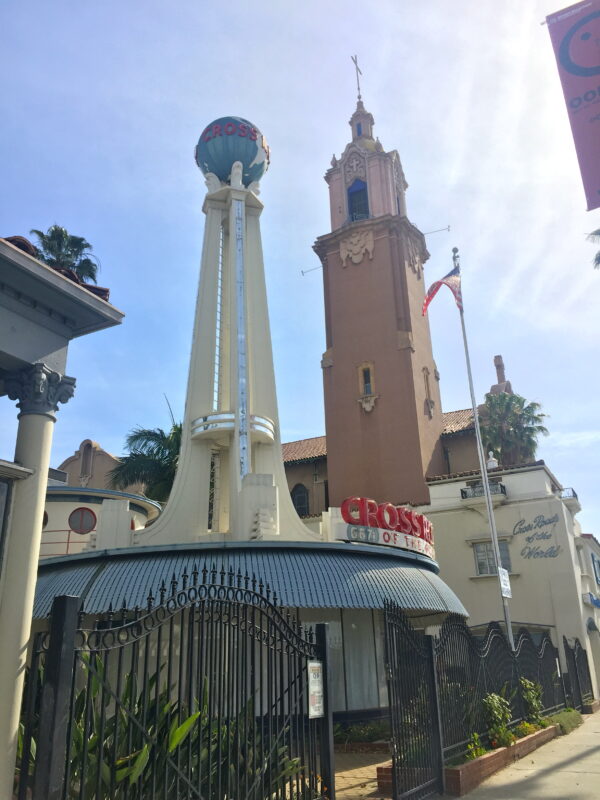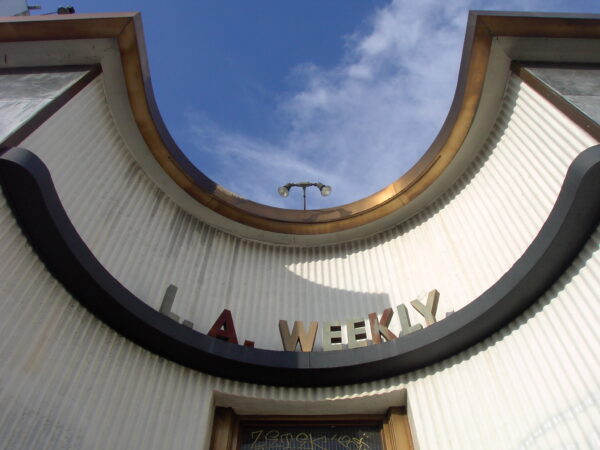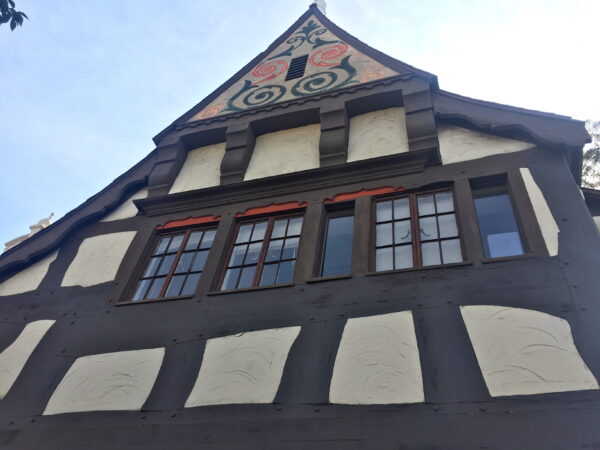
Place
Crossroads of the World
Completed in 1936, Crossroads of the World was one of the first outdoor shopping centers in the country.
Saved
The new mixed-use development at Crossroads will incorporate many of the historic buildings, as well as the historic Hollywood Reporter Building.


Place Details
Address
Get directions
Architect
Year
Decade
Property Type
Government Officials
Community

Laura Dominguez/L.A. Conservancy
Overview
Designed by local architect Robert V. Derrah, Crossroads of the World is one of Los Angeles’ most recognizable properties and one of the first outdoor shopping centers. The Hollywood complex was completed in 1936 and conceived as a cosmopolitan shopping center featuring merchandize from around the globe. The site also contains the Streamline Moderne Hollywood Reporter Building.
In 2015, a proposed seven-acre mixed-use development proposal threatened the site’s future. Advocacy from the L.A. Conservancy, Art Deco Society, and Hollywood Heritage, saved a cluster of these historic buildings, which were integrated into the new project.
About This Place
About This Place
Crossroads of the World is emblematic of Hollywood’s development during the 1930s, from its cosmopolitan ambitions to its architectural spectacle. The juxtaposition of styles evoked the feeling of an international bazaar, as might be found on a movie set in a nearby studio.
Oriented around a centralized Streamline Moderne structure, Crossroads of the World was envisioned as a hub of pedestrian activity. The complex features a programmatic nautical theme, paired with architectural styles found around the world. Derrah designed the central building, which faces Sunset Boulevard, in the form of a ship, which “sails” down an international street lined with shops.
The assembled village gave Angelinos a highly glamorized taste of the world at the height of the Great Depression, one that might otherwise be inaccessible, and its Streamline Moderne centerpiece embodied the optimism of the era’s technological growth. Its boosters envisioned it as a permanent World’s Fair facility, transporting shoppers to exotic settings while offering them a variety of wares and services.
When Crossroads officially debuted in 1936, the press covered the event as it would a movie premiere. The complex was hailed as “an outstanding landmark and civic attraction” and featured in numerous architectural journals. The combination of high end retail, coffee shops, and professional offices made it a gathering place for international celebrities and Hollywood movers and shakers, and its subsequent life cycles mirrored Hollywood’s evolution throughout the twentieth century.
In addition to Crossroads, Derrah was responsible for a number of significant commissions in Los Angeles during the 1930s. Many of his buildings were designed in the Streamline Moderne style, including the Coca-Cola Building (1939). He also designed an addition to John and Donald Parkinson’s Southern California Gas Company Complex (1942) and contributed to the Fairfax Farmers Market (1934).
In the 1940s and ’50s, Crossroads began its transition from shopping center to office complex, housing such tenants as the Screen Actors Guild, Standard Oil, and American Airlines. It was threatened with demolition in the 1970s, but was rescued and revitalized when an investor stepped forward. It subsequently attracted a new wave of creative tenants, including music producers, record companies, screenwriters, costume designers, and casting agencies.
Our Position
In our Notice of Preparation (NOP) and Draft Environmental Review (DEIR) comments, the Conservancy applauded the applicant’s decision to retain, preserve, and rehabilitate the iconic Crossroads of the World as part of the project. We emphasized the importance of incorporating compatible, appropriately-scaled new construction into the project site in order to protect the integrity of the historic complex. We also advocated for the preservation of several more 1930s structures, including the Hollywood Reporter Building and historic residential structures, that were originally slated for demolition.




















